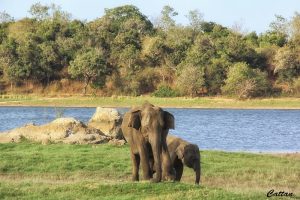The New Seven Wonders of Africa
In 2013, the New Seven Natural Wonders of Africa were officially declared in Arusha Tanzania. They were determined by insights and knowledge from experts around the world, with a key focus on conservationists such as members of the International Union for the Conservation of Nature. Victoria Falls, known as one of the Seven Natural Wonders of the World, served as ambassador to these deservedly-named natural wonders.
Mount Kilimanjaro, Tanzania
Mount Kilimanjaro, the highest free-standing mountain globally, also claims the title of Africa’s highest peak, soaring approximately 5895 meters above sea level. This enormous stratovolcano, formed millions of years ago, boasts two extinct peaks, while Kibo, though dormant, retains the potential for eruption.
Scaling Mount Kilimanjaro requires no advanced climbing equipment or prior experience at such altitudes. However, altitude sickness poses a significant challenge, with less than half the oxygen available at sea level atop the summit. Summiting Kilimanjaro is a daunting endeavor, but it promises a feeling of triumph unparalleled elsewhere!
Ngorongoro Crater, Tanzania
Spanning about 20km in width, the Ngorongoro Crater serves as a haven for diverse wildlife, benefitting from permanent water and pasture sources. Situated within the Ngorongoro Conservation Area, this crater encompasses highland plains, scrub bush, and vast forests over thousands of square kilometers.
This region offers unparalleled game-viewing opportunities, ensuring encounters with the Big Five and myriad other wildlife species.
Serengeti National Park, Tanzania
As Tanzania’s second-largest and most renowned national park, the Serengeti boasts global fame for its incredible wildlife. Its ecosystem extends beyond park borders to include other conservation areas and reserves, such as Kenya’s famed Masai Mara.
This expansive area facilitates the awe-inspiring Great Migration, where millions of wildebeest, zebra, and other animals undertake an annual circulatory migration, impacting every level of the food chain.
The Nile River, Egypt
Stretching 6650 km, the Nile River claims the title of the world’s longest river and holds immense importance for the continent’s inhabitants, sustaining life in regions otherwise uninhabitable. Flowing through 11 countries from central Africa to the Nile Delta in Egypt, the river has been crucial for agriculture and transportation, supporting the construction of monumental structures still admired today.
The Red Sea Reef, Egypt
For diving enthusiasts, the Red Sea offers unparalleled opportunities, known globally as one of the premier diving destinations. Extending over 1240 miles along the coasts of Egypt, Sudan, and Eritrea, the Red Sea Reef is home to nearly 1,100 fish species, with approximately 10% exclusive to the region.
Explore the depths of the Red Sea in Egypt!
Sahara Desert, Morocco
As the world’s hottest desert and third-largest after Antarctica and the Arctic, the Sahara dominates much of North Africa. With temperatures often surpassing 50 degrees Celsius and dropping near freezing at night in colder regions, the Sahara boasts colossal dunes, some towering up to 180 meters high.
Okavango Delta, Botswana
As the world’s largest inland delta, the Okavango Delta teems with life and features enchanting islands. Created by seasonal flooding, the delta swells to two to three times its regular size during peak months, attracting wildlife from miles around and forming one of Africa’s most concentrated wildlife habitats.




